

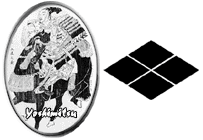 Minamoto Yoshimitsu was the son of Prince Minamoto Yoriyoshi (lord of Chinjuf) and a direct descendant of Emperor Seiwa.
Minamoto Yoshimitsu was the son of Prince Minamoto Yoriyoshi (lord of Chinjuf) and a direct descendant of Emperor Seiwa.
Emperor Seiwa was a lackluster leader as most Japanese emperors were. Yoshimitsu inherited an art that had been developed by his forefathers and is said to be related to Sumo; he perfected this discipline, which was to be the roots of what is now known as Daito Ryu (Daito was the name of Yoshimitsu's summer residence). Legend has it that in creating new techniques he is said to have been influenced by observing the movements of a spider trapping its prey.
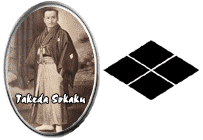 Takeda Sokaku was born the second son of Takeda Sokichi on October 10, 1859, in the Takeda mansion in Oike in Aizu, present-day Fukushima prefecture. As a boy, Sokaku learned kenjutsu, bojutsu,
sumo, and Daito-ryu from his father, and studied Ono-ha Itto-ryu at the Yokikan dojo under Shibuya Toba.
Takeda Sokaku was born the second son of Takeda Sokichi on October 10, 1859, in the Takeda mansion in Oike in Aizu, present-day Fukushima prefecture. As a boy, Sokaku learned kenjutsu, bojutsu,
sumo, and Daito-ryu from his father, and studied Ono-ha Itto-ryu at the Yokikan dojo under Shibuya Toba.
With the beginning of the Meiji period, the age of the sword had ended, and no matter how skilled a swordsman might be, he can no longer make any mark and will amount to nothing. Therefore, it is time to pursue and make your way with jujutsu.
With this, the formal succession of Daito-ryu aiki jujutsu was assured. From that time on Sokaku identified himself as a practitioner of both Daito-ryu aiki jujutsu and Ono-ha Itto-ryu. He traveled around Japan teaching both arts and came to be recognized as the reviver of Daito-ryu (chuko no so).
In his later years Sokaku focused his activities in Hokkaido. He passed away on April 25, 1943, at the age of eighty-three while teaching in Aomori Prefecture.
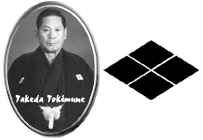 Tokimune was born on October 7, 1916 in Shimoyubetsu in Hokkaido. As a boy,
his father trained him strictly in swordsmanship and Daito-ryu aiki jujutsu. Previous to this time, Daito-ryu had been for the most part, an exclusive art taught only to prominent
individuals such as descendants of the samurai class, military officers, and teachers. Tokimune, however, began working toward sharing the art with a wider audience by conducting
what he called "Soke Seminars" in various places around Japan. As a result of these seminars, the previously hidden techniques of Daito-ryu were revealed to the public
as Daito-ryu aiki budo. On February 7, 1981 Tokimune presented Daito-ryu at a major public demonstration of classical martial arts that was broadcast on Japanese national television.
Tokimune was born on October 7, 1916 in Shimoyubetsu in Hokkaido. As a boy,
his father trained him strictly in swordsmanship and Daito-ryu aiki jujutsu. Previous to this time, Daito-ryu had been for the most part, an exclusive art taught only to prominent
individuals such as descendants of the samurai class, military officers, and teachers. Tokimune, however, began working toward sharing the art with a wider audience by conducting
what he called "Soke Seminars" in various places around Japan. As a result of these seminars, the previously hidden techniques of Daito-ryu were revealed to the public
as Daito-ryu aiki budo. On February 7, 1981 Tokimune presented Daito-ryu at a major public demonstration of classical martial arts that was broadcast on Japanese national television.
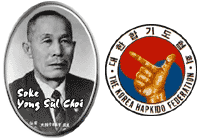 In 1904 Grandmaster Choi, Yong Sul was born in the Korean province of Chung Buk.
He was kidnapped and taken to Japan by Mr. Morimoto at the age of eight. After being picked up by the police he came into a buddhistic temple to a monk name Kintaro Wadanbi. There he lived for 2
years. Wadanbi sent him to his friend Sokaku Takeda, head of the Daito-Ryu Aiki Ju-Jutsu. Here he became a live-in student as a servant to Sokaku Takeda for 30 years. He was ordered to go back to
Korea by Sokaku Takeda. In 1951 Grandmaster Choi and Suh, Bok-Sup together opened up a Dojang named Korean Yu Kwan Sool Hop Ki Dolang. In 1958 Grandmaster Choi, Suh and Bok-Sup decided to change
the name of the Martial Art taught by them into HopKiDo. He died in 1986 at the age of 82 and was buried in Taegu.
In 1904 Grandmaster Choi, Yong Sul was born in the Korean province of Chung Buk.
He was kidnapped and taken to Japan by Mr. Morimoto at the age of eight. After being picked up by the police he came into a buddhistic temple to a monk name Kintaro Wadanbi. There he lived for 2
years. Wadanbi sent him to his friend Sokaku Takeda, head of the Daito-Ryu Aiki Ju-Jutsu. Here he became a live-in student as a servant to Sokaku Takeda for 30 years. He was ordered to go back to
Korea by Sokaku Takeda. In 1951 Grandmaster Choi and Suh, Bok-Sup together opened up a Dojang named Korean Yu Kwan Sool Hop Ki Dolang. In 1958 Grandmaster Choi, Suh and Bok-Sup decided to change
the name of the Martial Art taught by them into HopKiDo. He died in 1986 at the age of 82 and was buried in Taegu.
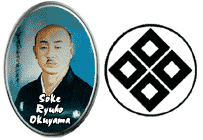 Okuyama Yoshiharu (Yoshiji) was born on February 21, 1901, in Yachi-cho, Nishi
Mu-rayama, Yamagata Prefecture, to a former samurai family of the upper Mogami River area. Not a great deal is known about his early years except that he was active in various bujutsu-ryu (martial
arts systems) and studied traditional Oriental medicine.
Okuyama Yoshiharu (Yoshiji) was born on February 21, 1901, in Yachi-cho, Nishi
Mu-rayama, Yamagata Prefecture, to a former samurai family of the upper Mogami River area. Not a great deal is known about his early years except that he was active in various bujutsu-ryu (martial
arts systems) and studied traditional Oriental medicine.
Mr. Okuyama's First Dojo
Upon finishing his studies with Takeda in 1938, Mr. Okuyama published the first of what was to be many of his martial arts texts entitled, "Daito-ryu
Goshinjutsu" (The Daito System of Self-Protection).
"The Spine Of A Dragon"
Finally, on June 1, 1941, at the Shiba Tenso Jinja (Shinto shrine in the Shiba district of Tokyo}, he held the Hakko-ryu, Kaiso Hokokusai [Ceremony
Proclaiming to the Kami (Shinto deities} the Birth of Hakko-ryu]. From that day forward Mr. Okuyama took the pen name of Ryuho. Meaning "the spine of a dragon" and called his system Hakko-ryu
JuJutsu.
During the war he taught Hakko-ryu in its original form to many of the leaders in government and the military, and in 1943 renamed his dojo the Hakko-ryu Kobujuku (Private School of the Ancient Martial Art Hakko-ryu}.
In 1947, Mr. Okuyama quietly relocated to Saitama Prefecture where he established the Hakko Juku Hombu Dojo (Private Headquarters Dojo of Hakko-ryu).
Both the techniques and philosophy evolved until ultimately Hakko-ryu took its current form as a modern martial art (shin-bujutsu) which, in its essence, strives to create more justice in society through the introduction of humanitarian principles of se1f-protection. The groundwork for this was laid before the war and combined both medical and martial techniques. He died in November of 1987.
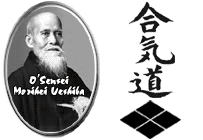 Aikido was founded early in this century by Morihei Ueshiba, or as he also known:
O'Sensei (an honorific term for a great teacher).
Aikido was founded early in this century by Morihei Ueshiba, or as he also known:
O'Sensei (an honorific term for a great teacher).
The first signs of Aikido appeared when Ueshiba became so absorbed in the study of kotodama and its deep and complex meaning of the soul and the universe. He departed from his familiar Yagyu-ryu and Daito-ryu jujitsu background styles, and he proceeded to try to converge the mind, body, and the spirit into a martial art of his own. By breaking down the walls that often split the three entities apart, Ueshiba was laying down the familiar triangular framework of Aikido. This early style of Aikido was first named aiki-bujitsu.
It was later during the 1940's that Aiki-budo was given the name of Aikido. By this time Ueshiba had developed Aikido into a martial art unifying the mind, body, and spirit. He taught that it was every martial artist's personal responsibility to preserve life and peace in the universe, rather than to fight.
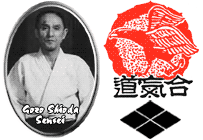
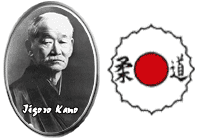 Jigoro Kano was born in 1860 in Kobe, Japan into a wealthy family. In 1877, as a college
student, he studied Tenshin-Shinyo Jujitsu under Hachinosuke Fukuda and Masatomo Iso.
Jigoro Kano was born in 1860 in Kobe, Japan into a wealthy family. In 1877, as a college
student, he studied Tenshin-Shinyo Jujitsu under Hachinosuke Fukuda and Masatomo Iso.
In 1880 Kano began his studies of Kito-Ryu under Tsunetoshi Iikubo. The Kito-Ryu emphasized nagewaza (throwing techiniques). These techniques complemented the grappling techniques of Tenshin-Shinyo Ryu.
In 1882 Kano founded Kodokan Judo. His system of martial arts (Judo) all but replaced the parent arts of jujitsu in Japan. Kano, was an educator and was successful in introducing Judo into the Japanese school system.
Kano traveled the world spreading judo to many nations and died in 1938 on board the ship SS Hikawa Maru on a return voyage from Cairo where he had met with an Olympic committee. It was his dream to have judo in the Olympic games.
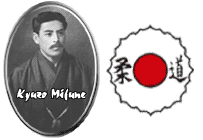 World War II was a watershed for Kodokan Judo. Kano's death before the war, wartime demands
and the Japanese surrender, and postwar occupation and the martial arts ban all contributed to a time of uncertainty in Judo, as in Japan. Kodokan's resurgence after the War was due primarily to two
individuals: Kyuzo Mifune and US Air Force General Curtis LeMay.
World War II was a watershed for Kodokan Judo. Kano's death before the war, wartime demands
and the Japanese surrender, and postwar occupation and the martial arts ban all contributed to a time of uncertainty in Judo, as in Japan. Kodokan's resurgence after the War was due primarily to two
individuals: Kyuzo Mifune and US Air Force General Curtis LeMay.
At Kano's death in 1938, Jiro Nango became president of the Kodokan, but Mifune became the most influential instructor. Students had long complained that Mifune would get carried away with lectures, and he was viewed as "feared, more than loved." May 25, 1945, he was elevated to Judan (10th), the fourth of seven men to ever be so honored. In 1956, he wrote his classic book, Canon of Judo, still a remarkable exposition of Judo history, philosophy, and technical description.
Mifune's influence on post-war Judo cannot be underestimated. His skill was perhaps the most elegant ever seen at the Kodokan. His dynamic and fluid Judo was a natural basis for the explosive development of sport Judo around the world. Indeed, Trevor Leggett, a frequent visitor to the Kodokan over many years, remarked that Judo was much "rougher" at the Kodokan prior to World War II, as opposed to afterward. This was, perhaps, the influence of Mifune.
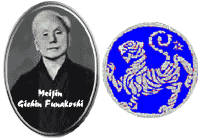 Gichin Funakoshi, often referred to as the "father of modern karate,"
was born in Shuri, Okinawa in 1868 to the privileged Shizoku class. The truth of the matter was that when Funakoshi was eleven years old, he became close friends with one of his school mates, the son
of the famed Shuri-te karate master, Yasutsune Azato. Funakoshi took notice that his friend possessed certain skills and, as his interest was peeked, he and his friend began "playing" at karate.
As Funakoshi's general health condition improved, his physician, Tokashiki, took notice and urged Funakoshi's grandfather to solicit Master Azato to accept Funakoshi, formally, as a karate student.
Gichin Funakoshi, often referred to as the "father of modern karate,"
was born in Shuri, Okinawa in 1868 to the privileged Shizoku class. The truth of the matter was that when Funakoshi was eleven years old, he became close friends with one of his school mates, the son
of the famed Shuri-te karate master, Yasutsune Azato. Funakoshi took notice that his friend possessed certain skills and, as his interest was peeked, he and his friend began "playing" at karate.
As Funakoshi's general health condition improved, his physician, Tokashiki, took notice and urged Funakoshi's grandfather to solicit Master Azato to accept Funakoshi, formally, as a karate student.
Master Azato did accept Funakoshi and, needless to say, the history of karate-do was changed forever. But, Funakoshi learned more than just karate-do from Master Azato, who was a well-educated man with high social status. It was largely due to Master Azato that Funakoshi was well prepared to pass the exams which allowed him to work in the public schools as a teacher. It was due also to this relationship with Azato that he met and was able to train with some of the best karate masters of his day, including Master Itosu, a master of Naha-te, and the great "Bushi" Matsumura.
Until Funakoshi was 34 years old (1902), due to a 400-year ban on the practice and study of the martial arts, he had to practice his art in secrecy.
On January 29, 1939, Gichin Funakoshi entered not only the very first karate dojo, but his own very first dojo. Students from all over Japan had joined forces and raised funds to pay tribute in this way to the little karate teacher with the big dream. They had hung a plaque over the door inscribed with the characters for "Shoto-kan" or "hall of Shoto." Thus, the first recorded recognition of Funakoshi's karate as a style of his own -- Shotokan.
He remained active in the process and the propagation of karate-do until his death in 1957.
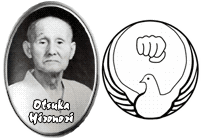 Otsuka Hironori, the founder of the Wado Ryu style of karate, was born on June 1, 1892,
the second of four children. His father Otsuka Tokujiro operated a clinic at their home in Shimodate, Ibaraki prefecture.
Otsuka Hironori, the founder of the Wado Ryu style of karate, was born on June 1, 1892,
the second of four children. His father Otsuka Tokujiro operated a clinic at their home in Shimodate, Ibaraki prefecture.
His mother's uncle, Chojiro Ebashi was a samurai warrior who is said to have kept the young boy spellbound with his exciting tales of adventure. Here perhaps we can see the sowing of the seeds of fascination for the martial arts that was to stay with Otsuka throughout his life.
Otsuka studied in the martial arts from a very young age, beginning his instruction under his father and his great uncle Ebashi, who was chief martial arts instructor of the Tsuchiura Clan. On April 1 1897, at the age of six, the young Otsuka enrolled in the school of Yokiyoshi Nakayama Tatsusaburo (1870-1933), Master of Shindo Yoshin Ryu school of Ju Jutsu, who was also a kendo instructor.
In May 1934, when he was 43, Master Otsuka started his own school called the Dai Nippon Karate Shinko Club (Dai = great, Nippon = Japan, Shinko = to promote, bu = martial, kai = association). Here would be the centre of Otsuka's teaching of his new systems of Wado-Ryu Karate-Jutsu and Wado-Ryu-Jujutsu kenpo, merging Okinawan karate with traditional Japanese jujutsu. When the Budo-kai requested a name for each style and school, in 1940, Otsuka's martial art was officially named the Wado-Kai and later Wado-Ryu. It was the chairman of the Dai Nippon Karate Shinko Club, Eriguchi Eiichi who gave this style of karate the name Wado-Ryu.
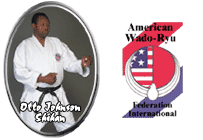 The Goshin Budokan U.S.A. Shubukan Martial Arts Center is a Wadokai (branch school).
The Goshin Budokan U.S.A. Shubukan Martial Arts Center is a Wadokai (branch school).
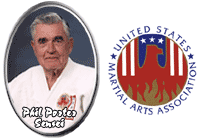 Founder of United States Martial Arts Association - Father of American Kodokan Judo & Former President of USJA Biography
Founder of United States Martial Arts Association - Father of American Kodokan Judo & Former President of USJA Biography
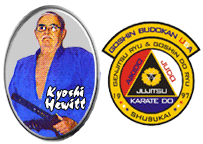 Founder and Dojocho of the Goshin Budokan U.S.A Sleeping Dragon Judo Club
(Biography : HTML | PDF)
Founder and Dojocho of the Goshin Budokan U.S.A Sleeping Dragon Judo Club
(Biography : HTML | PDF)
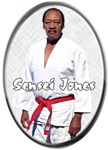 Founder of the Unidos Judo Clubs and President of the United States Judo Association (USJA) (Biography)
Founder of the Unidos Judo Clubs and President of the United States Judo Association (USJA) (Biography)